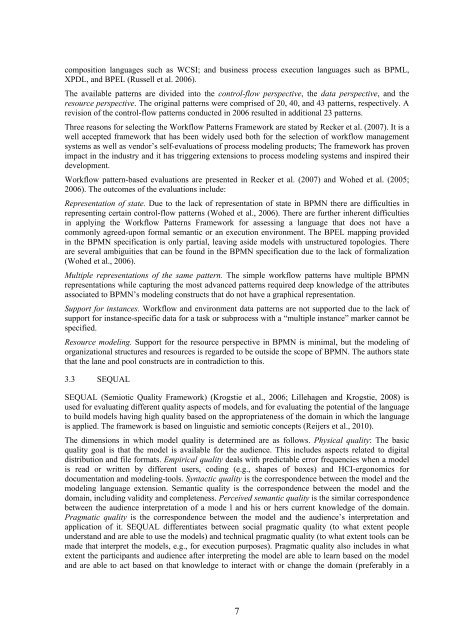Multi-channel provisioning of public services - Department of ...
Multi-channel provisioning of public services - Department of ...
Multi-channel provisioning of public services - Department of ...
Create successful ePaper yourself
Turn your PDF publications into a flip-book with our unique Google optimized e-Paper software.
composition languages such as WCSI; and business process execution languages such as BPML,<br />
XPDL, and BPEL (Russell et al. 2006).<br />
The available patterns are divided into the control-flow perspective, the data perspective, and the<br />
resource perspective. The original patterns were comprised <strong>of</strong> 20, 40, and 43 patterns, respectively. A<br />
revision <strong>of</strong> the control-flow patterns conducted in 2006 resulted in additional 23 patterns.<br />
Three reasons for selecting the Workflow Patterns Framework are stated by Recker et al. (2007). It is a<br />
well accepted framework that has been widely used both for the selection <strong>of</strong> workflow management<br />
systems as well as vendor’s self-evaluations <strong>of</strong> process modeling products; The framework has proven<br />
impact in the industry and it has triggering extensions to process modeling systems and inspired their<br />
development.<br />
Workflow pattern-based evaluations are presented in Recker et al. (2007) and Wohed et al. (2005;<br />
2006). The outcomes <strong>of</strong> the evaluations include:<br />
Representation <strong>of</strong> state. Due to the lack <strong>of</strong> representation <strong>of</strong> state in BPMN there are difficulties in<br />
representing certain control-flow patterns (Wohed et al., 2006). There are further inherent difficulties<br />
in applying the Workflow Patterns Framework for assessing a language that does not have a<br />
commonly agreed-upon formal semantic or an execution environment. The BPEL mapping provided<br />
in the BPMN specification is only partial, leaving aside models with unstructured topologies. There<br />
are several ambiguities that can be found in the BPMN specification due to the lack <strong>of</strong> formalization<br />
(Wohed et al., 2006).<br />
<strong>Multi</strong>ple representations <strong>of</strong> the same pattern. The simple workflow patterns have multiple BPMN<br />
representations while capturing the most advanced patterns required deep knowledge <strong>of</strong> the attributes<br />
associated to BPMN’s modeling constructs that do not have a graphical representation.<br />
Support for instances. Workflow and environment data patterns are not supported due to the lack <strong>of</strong><br />
support for instance-specific data for a task or subprocess with a “multiple instance” marker cannot be<br />
specified.<br />
Resource modeling. Support for the resource perspective in BPMN is minimal, but the modeling <strong>of</strong><br />
organizational structures and resources is regarded to be outside the scope <strong>of</strong> BPMN. The authors state<br />
that the lane and pool constructs are in contradiction to this.<br />
3.3 SEQUAL<br />
SEQUAL (Semiotic Quality Framework) (Krogstie et al., 2006; Lillehagen and Krogstie, 2008) is<br />
used for evaluating different quality aspects <strong>of</strong> models, and for evaluating the potential <strong>of</strong> the language<br />
to build models having high quality based on the appropriateness <strong>of</strong> the domain in which the language<br />
is applied. The framework is based on linguistic and semiotic concepts (Reijers et al., 2010).<br />
The dimensions in which model quality is determined are as follows. Physical quality: The basic<br />
quality goal is that the model is available for the audience. This includes aspects related to digital<br />
distribution and file formats. Empirical quality deals with predictable error frequencies when a model<br />
is read or written by different users, coding (e.g., shapes <strong>of</strong> boxes) and HCI-ergonomics for<br />
documentation and modeling-tools. Syntactic quality is the correspondence between the model and the<br />
modeling language extension. Semantic quality is the correspondence between the model and the<br />
domain, including validity and completeness. Perceived semantic quality is the similar correspondence<br />
between the audience interpretation <strong>of</strong> a mode l and his or hers current knowledge <strong>of</strong> the domain.<br />
Pragmatic quality is the correspondence between the model and the audience’s interpretation and<br />
application <strong>of</strong> it. SEQUAL differentiates between social pragmatic quality (to what extent people<br />
understand and are able to use the models) and technical pragmatic quality (to what extent tools can be<br />
made that interpret the models, e.g., for execution purposes). Pragmatic quality also includes in what<br />
extent the participants and audience after interpreting the model are able to learn based on the model<br />
and are able to act based on that knowledge to interact with or change the domain (preferably in a<br />
7
















